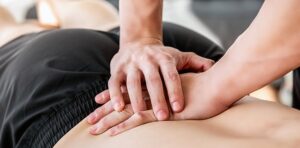
What is that Popping Sound?
If you have been adjusted before by a chiropractor you may have noticed a popping sound that may seem a little strange. Many people think all kinds of strange things about this popping sound, so what actually is it?
The Proof
It’s now clear that the popping sound that may occur when you get adjusted is only the formation of gas within a joint, and it’s no more significant than any other gas release from the body. The popping sound does not mean that you’re getting arthritis. A number of studies have looked at people who have routinely cracked their knuckles for years and years and compared them to non-knuckle crackers to see if there’s any difference in x-ray images of their hands.1
The popping sound does not actually matter at all
Knuckle Cracking and Arthritis?
These studies all came back with the same conclusion. Habitual knuckle cracking over the course of several decades is not associated with clinical or radiographic evidence of osteoarthritis. Of course, you could argue that the spine is part of your weight-bearing system and hands are not, so you could ask, can you really compare the two?
 But all the evidence that is available suggests that making popping sounds from joints has nothing to do with arthritis.
But all the evidence that is available suggests that making popping sounds from joints has nothing to do with arthritis.
Does it matter?
The popping sound does not actually matter at all. Whether or not you hear the popping sound makes absolutely no difference to how good the adjustment was. There have been several research studies that have looked at whether adjustments with the popping sound meant there were better outcomes for the patients being adjusted, but all these studies show that it makes no difference whether or not there was a popping sound.2-3 All it really means is that the chiropractor adjusted you really fast. We do know that a faster adjustment speed means you are more likely to get a popping sound.4
 But this popping sound does not mean you will get better outcomes from your adjustment. Silent adjustments, if they improve spinal function, are just as good as loud popping ones.
But this popping sound does not mean you will get better outcomes from your adjustment. Silent adjustments, if they improve spinal function, are just as good as loud popping ones.
There have been all sorts of theories about what the popping sound really is. Some have thought the sound was caused by tendons snapping over a joint, or a bone being put back into place, or the snapping of adhesions or scar tissue.5 Recently there was a really interesting study done that actually looked at what was happening in a joint when there were popping sounds.6
MRI of joint cracking
The researchers in this study used video magnetic resonance imaging (MRI) to study what happened in a person’s finger joint when they pulled his finger until his knuckle made the popping sound. So, they used a cable attached to his finger and slowly pulled his finger until it cracked while recording this with video MRI.
They then measured the space between the joint surfaces, before and after the crack, using automatic computer software. What they found was that the joints remained very close together during the early stages of the finger being pulled, and then when the force of the pull was strong enough, the joint would very quickly separate and a bubble would form, and this was when the popping sound was heard. This means that the popping sound you hear when a chiropractor adjusts you is simply a change in state between liquid and gas within a joint.
 There is a really cool name for this too. It’s called tribonucleation – try that one after a few drinks. It’s actually very similar to what happens when you open a champagne bottle, but it’s all happening in an enclosed joint space.
There is a really cool name for this too. It’s called tribonucleation – try that one after a few drinks. It’s actually very similar to what happens when you open a champagne bottle, but it’s all happening in an enclosed joint space.
The popping sound you hear when a chiropractor adjusts you is simply a change in state between liquid and gas within a joint.
No Problem with popping
Early on, it was thought that the popping sound was associated with unhealthy joints, but as far back as the 1930’s scientists were showing that this also occurs in perfectly healthy joints. So, keep in mind next time you get adjusted by your chiropractor, that the popping sound doesn’t have anything to do with bones grinding or rubbing, but instead is simply gas bubbles forming within a joint as your adjustment separates two joint surfaces that are close together.
References
- Powers et al. The Journal of family practice 2016;65(10):725-26.
- Cleland et al. J Man Manip Ther 2007;15(3):143-54.
- Cramer et al. J Manipulative Physiol Ther 2011;34(9):572-83.
- Williams & Cuesta-Vargas. J Manipulative Physiol Ther 2014;37(4):230-5.
- Protopapas & Cymet. J Am Osteopath Assoc 2002;102(5):283-7.
- Kawchuk et al. PLoS One 2015;10(4):e0119470.

